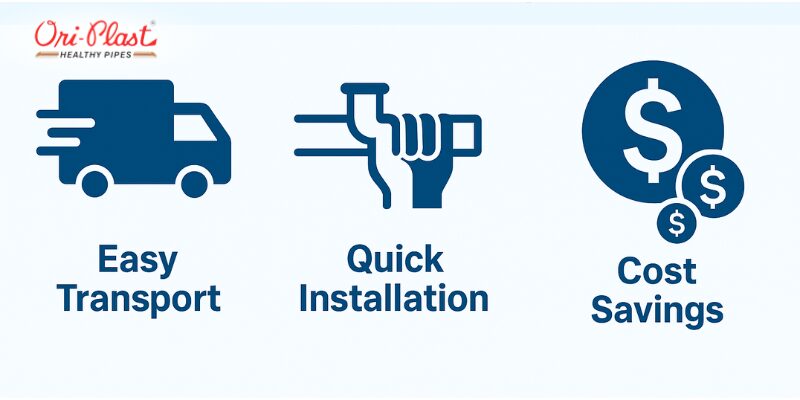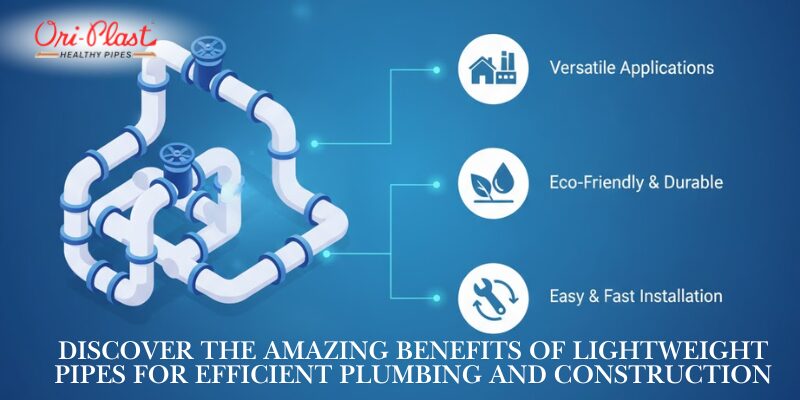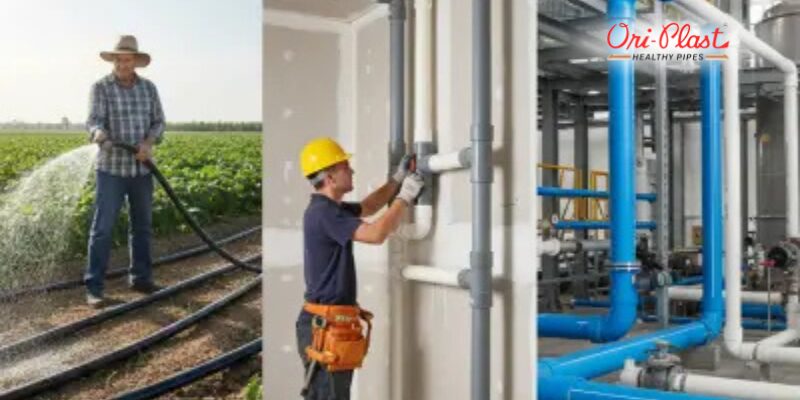In India’s evolving construction and infrastructure sector, particularly across regions like Assam, Kolkata, Odisha, Punjab, Raipur, Guwahati, and Jaipur, the advantages of lightweight pipes are redefining how builders and engineers approach plumbing and piping systems. The India pipes and fittings market size reached USD 659.7 Million in 2024. Looking forward, IMARC Group expects the market to reach USD 906.2 Million by 2033, exhibiting a growth rate (CAGR) of 3.59% during 2025-2033. The market is witnessing significant growth, driven by escalating demand for PVC and CPVC pipes in infrastructure development and the rise of PEX and multilayer composite pipes in residential and commercial plumbing.
With rapid urbanization and industrial expansion, the need for efficient, cost-effective, and durable piping solutions has never been greater. Lightweight pipes are increasingly preferred for their ease of transportation, simplified installation process, and impressive potential for cost savings.
Why Choose Lightweight Pipes? The Essentials

Easy Transportation and Handling
Transporting bulky, heavy pipes across cities or to remote project sites like Raipur and Odisha can be logistically challenging. Lightweight pipes solve this by reducing the load vehicles must carry, which significantly lowers freight costs and makes handling easier even in hard-to-access locations. In crowded urban hubs such as Kolkata and Guwahati, their lighter mass also decreases labor requirements for loading and unloading—helping boost safety and efficiency while minimizing risk of injury.
Quick and Efficient Installation
Lightweight pipes can be installed faster compared to traditional heavy materials. This is a considerable advantage in fast-developing cities like Jaipur and Punjab, where meeting tight construction timelines is essential. Their easy maneuverability through narrow spaces and multi-level buildings cuts down labor costs, reduces installation errors, and prevents potential damage. Additionally, compatibility with modern quick-fit or electrofusion fittings, commonly used in places such as Assam and Odisha, ensures seamless on-site assembly.
Cost Savings You Can Measure
When transportation and installation become simpler and quicker, projects save both time and money. Lightweight pipes significantly reduce budgets by lowering delivery charges, wage costs, and working hours needed for setup. This makes them an ideal choice for municipal projects and private developments in cities like Guwahati and Raipur, where financial efficiency is vital. Their low maintenance needs and strong durability—especially PVC and PE versions—also translate into fewer repairs, as they resist corrosion and leaks far better than traditional steel or concrete options.
The Versatile Applications of Lightweight Pipes 
Agriculture & Irrigation
In agricultural regions such as Assam and Odisha, lightweight pipes are perfect for irrigation systems thanks to their corrosion resistance and quick installation. Farmers can set up durable water supply lines capable of withstanding extreme field conditions without frequent replacements.
Industrial Usage
Industries in Punjab and Jaipur value lightweight pipes for their chemical resistance and versatility in transporting a variety of liquids and gases. Their durability reduces operational downtime and maintenance, ensuring smooth and continuous industrial processes.
Residential and Commercial Construction
The real estate growth in Kolkata and Guwahati benefits heavily from lightweight pipes for plumbing installations. They are reliable for both hot and cold water supply and easy to install across high-rise or multi-storey projects.
Environmental Benefits of Lightweight Pipes
Lightweight piping systems contribute to sustainability objectives. Reduced weight means less fuel is needed during transport, lowering carbon emissions—a growing priority for India’s urban centers such as Jaipur and Raipur. Many designs are recyclable and have extended service lives, which further decreases material waste.
How to Select the Right Lightweight Pipes for Your Project
- Material: Choose HDPE or uPVC as per flexibility and durability requirements.
- Certification: Ensure compliance with ISI and international safety standards.
- Supplier Reliability: Partner with established manufacturers in regions such as Kolkata or Assam for timely delivery and strong after-sales support.
- Fitting Compatibility: Verify that your chosen pipes work with electrofusion or solvent welding assemblies for versatile solutions.
Maintenance and Longevity
From the humid climate of Guwahati to the dry regions near Jaipur, lightweight pipes demand minimal maintenance. They resist rust, UV degradation, and chemical exposure—helping them serve longer with fewer interventions, which adds peace of mind for both homeowners and project developers.
Conclusion
The proven benefits of lightweight pipes—spanning easier transport, faster installation, measurable cost savings, and environmental gains—make them an ideal choice for modern India’s construction and industrial requirements. From Assam’s farmlands to Kolkata’s commercial hubs, and from Odisha’s developing urban zones to Punjab’s industrial centers, these solutions are helping projects achieve greater efficiency, reliability, and sustainability. By factoring in these advantages along with India’s steadily growing pipes and fittings market, stakeholders can confidently invest in systems that meet both present needs and future infrastructure goals.
Faqs'
Are lightweight pipes durable enough for commercial use?
Yes, modern lightweight pipes made from materials like PVC and PE are strong, resistant to corrosion and chemicals, and perform well under commercial conditions, including high pressure and varied climates.
How do lightweight pipes save transportation costs?
Their reduced weight means more pipes can be transported per trip, lowering fuel consumption and transport expenses, especially beneficial in regions with complex logistics like Assam and Odisha.
Can lightweight pipes be used in irrigation systems?
Absolutely. Lightweight pipes are widely used for irrigation as they’re easy to install and resist damage from soil and weather, making them popular in agricultural states like Punjab.
What materials are used for lightweight pipes?
Common materials include PVC (Polyvinyl Chloride), PE (Polyethylene), and CPVC (Chlorinated Polyvinyl Chloride), all offering lightweight properties with excellent durability.
How fast is the installation process for lightweight pipes?
Significantly faster than traditional metal or concrete pipes, as they are easier to handle, cut, and join with simple fittings, reducing labor time drastically.
Are lightweight pipes suitable for underground plumbing?
Yes, they are corrosion-resistant and durable enough for underground use, commonly applied in water supply and drainage systems.
Can lightweight pipes handle high water pressure?
Many lightweight pipes, particularly high-quality PE and CPVC variants, are rated for high-pressure applications, ensuring reliability in both residential and industrial projects.
How environmentally friendly are lightweight pipes?
Lightweight pipes often have a lower carbon footprint due to reduced transport emissions and their recyclability, supporting sustainability goals in construction.
What maintenance do lightweight pipes require?
They generally require minimal maintenance as they resist corrosion and scale buildup, saving time and money over their lifespan.
How do lightweight pipes compare to metal pipes?
They are lighter, easier to install, corrosion-resistant, and often more cost-effective, though they might have different pressure or temperature limits depending on the material.
Are lightweight pipes resistant to chemical corrosion?
Yes, materials like PVC and PE exhibit excellent resistance to most chemicals and water contaminants.
How do lightweight pipes help reduce labor costs?
Easier handling, cutting, and joining mean fewer workers are needed, and installation times are shorter, directly lowering labor costs.
Which cities in India benefit most from lightweight pipe technology?
Rapidly developing and infrastructure-intensive cities such as Kolkata, Jaipur, Guwahati, Raipur, and industrial zones in Odisha and Punjab see major benefits from lightweight pipe use.
How is the quality of lightweight pipes ensured?
Quality is verified through certifications like ISO standards, rigorous manufacturing controls, and compliance with national and international piping norms.
Can lightweight pipes be recycled?
Yes, many PVC and PE pipes are recyclable, contributing to waste reduction and circular economy efforts.
What are common applications of lightweight pipes in construction?
They are used in plumbing, irrigation, drainage, sewerage, water supply, and industrial piping systems.


